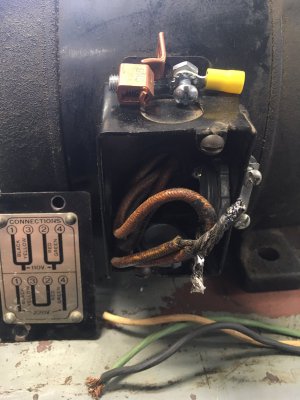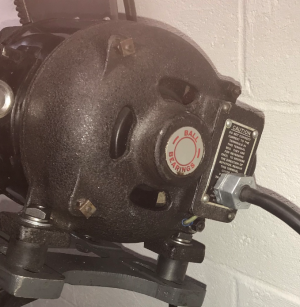Hi: Just pulled the old wiring out of my Atlas 7B shaper and running a new power cord. Is it worth adding a ground to the motor? If so, what is best practice? I found a copper ground lug and also have some star washers to use with a post and ring terminal? Would I just drill a hole in wire box? Thanks for any input. Daniel
-
Welcome back Guest! Did you know you can mentor other members here at H-M? If not, please check out our Relaunch of Hobby Machinist Mentoring Program!
You are using an out of date browser. It may not display this or other websites correctly.
You should upgrade or use an alternative browser.
You should upgrade or use an alternative browser.
Adding ground to Atlas motor?
- Thread starter Birdpath
- Start date
- Joined
- Mar 22, 2014
- Messages
- 847
Last edited:
- Joined
- Dec 25, 2011
- Messages
- 10,511
Right. Never use a 2-wire cord on a motor. Always install a cord with a green ground wire (if the only cord coming to the motor is from a reversing switch and the line cord goes to the switch instead of the motor, then the cord to the motor needs 5 wires, not 3).
Yes do it.
I have (had) two pieces of old equipment in the shop that did not have grounds. A bench grinder and an old Craftsman drill press that belonged to my step father. A recent rearrangement in the shop put them close together, and as a result I got bit. I was using a wire wheel on the grinder on a long rod to clean up some threads on the end. I took a good shock to the arm that was resting on the drill press table to steady the rod. Needless to say the drill press is now grounded and the bench grinder has the plug cut off until I can take it apart to rewire it.
I have (had) two pieces of old equipment in the shop that did not have grounds. A bench grinder and an old Craftsman drill press that belonged to my step father. A recent rearrangement in the shop put them close together, and as a result I got bit. I was using a wire wheel on the grinder on a long rod to clean up some threads on the end. I took a good shock to the arm that was resting on the drill press table to steady the rod. Needless to say the drill press is now grounded and the bench grinder has the plug cut off until I can take it apart to rewire it.
- Joined
- Apr 30, 2015
- Messages
- 11,284
Find a screw that goes directly to the motor frame. If the motor box is screwed to the motor, then put your lug under one of those screws, with lockwashers. You can also use one of the 4 motor case bolts to attach to. Using the box cover screws is possible but the least desirable- it can vibrate loose.
-Mark
-Mark
- Joined
- Dec 25, 2011
- Messages
- 10,511
And after you get everything hooked up but before you button it up and plug the AC line cord into the AC socket, do the following.
Using an analog ohmmeter or multimeter (not a digital one), set it to the lowest Ohms range (probably R X 1) and Zero it. Connect it to the two flat blades of the line plug (US 120 VAC standard) or to the two Hot pins or blades (all 220 to 240 volt systems). There should be no reading with the switch OFF.
Turn the motor switch ON (with a FWD-OFF-REV switch make the test twice, for both directions). The meter should indicate a few ohms. It should not read Zero other than possibly momentarily. If it does, either you have made a wiring error or something is shorted to Case . Either fix the error, fix the motor, or scrap the motor.
Change to the highest Ohms range (probably R X 10K) and zero the meter. Connect the meter leads to the ground pin and either or both of the other two pins or blades of the line plug. With the switch off, the meter should read Infinity. Turn on the motor switch or turn it to FWD and then REV. The meter should continue to read Infinity. If not, fix the wiring, fix the motor or scrap the motor.
Using an analog ohmmeter or multimeter (not a digital one), set it to the lowest Ohms range (probably R X 1) and Zero it. Connect it to the two flat blades of the line plug (US 120 VAC standard) or to the two Hot pins or blades (all 220 to 240 volt systems). There should be no reading with the switch OFF.
Turn the motor switch ON (with a FWD-OFF-REV switch make the test twice, for both directions). The meter should indicate a few ohms. It should not read Zero other than possibly momentarily. If it does, either you have made a wiring error or something is shorted to Case . Either fix the error, fix the motor, or scrap the motor.
Change to the highest Ohms range (probably R X 10K) and zero the meter. Connect the meter leads to the ground pin and either or both of the other two pins or blades of the line plug. With the switch off, the meter should read Infinity. Turn on the motor switch or turn it to FWD and then REV. The meter should continue to read Infinity. If not, fix the wiring, fix the motor or scrap the motor.
Last edited:
- Joined
- Jul 10, 2013
- Messages
- 1,189
Let's go one step further. You most likely have a two prong AC plug. I'd change the cord to a three prong plug with a color coded wire. Green is your ground and that goes to the motor case and the round prong. Black is the hot and it goes to the on/off switch and then to the motor and the small prong. White is the neutral goes to motor and the wide prong on the plug. I'll add that some cords already have a plug. Still, follow the color code.



